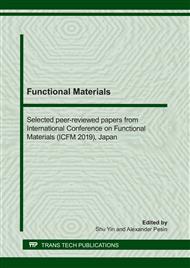p.3
p.9
p.15
p.21
p.27
p.33
p.39
p.45
Preparation and Characterization of Surface-Modified Nanocellulose Fibers for Water-Based Coating Application
Abstract:
Nanocellulose fibers (NCF) is a renewable biodegradable polymer in nature. It has extensively interest as a reinforcement material in nanocomposites due to its nanoscale advantages. However, the efficiency of NCF dispersion in polymer matrix has limitation due to its self-agglomeration.The objective of this research was to prepare surface-modified NCF using three different acids; succinic anhydride, phthalic anhydride and citric acid. The molar ratios of acid to anhydroglucose units in NCF used in this work were 6:1, 8:1 and 10:1. The effects of acid types and molar ratios toward physical properties were studied. The results showed that succinic anhydride-modified NCF provided the highest DS range from 0.46-0.86. Dispersion of succinic anhydride-modified NCF provided good stability in water for 30 days. The succinic anhydride-modified NCF of 1:6 molar ratio is suitable for emulsion coating application.
Info:
Periodical:
Pages:
21-26
Citation:
Online since:
May 2020
Authors:
Price:
Сopyright:
© 2020 Trans Tech Publications Ltd. All Rights Reserved
Share:
Citation:


